Quantum-dot LEDs (QLEDs) have significant potential applications in the next generation of displays and solid-state lighting due to their unique features of tunable emission color, high color saturation, high brightness, and simple solution processability. Traditional QLEDs based on pn junction structure typically operate under direct current (DC). Therefore, to drive QLEDs, driver circuits are necessary to convert household alternating current (220 V/50 Hz) into low-voltage DC through steps such as voltage reduction and rectification. Additionally, a DC-DC current regulation circuit is required to tune the brightness of QLEDs.
The use of driver circuits not only increases the complexity, cost, and power consumption but also reduces the robustness of QLED lamps. Moreover, continuous operation of QLEDs under DC leads to charge accumulation within the device, reducing its operational lifetime.
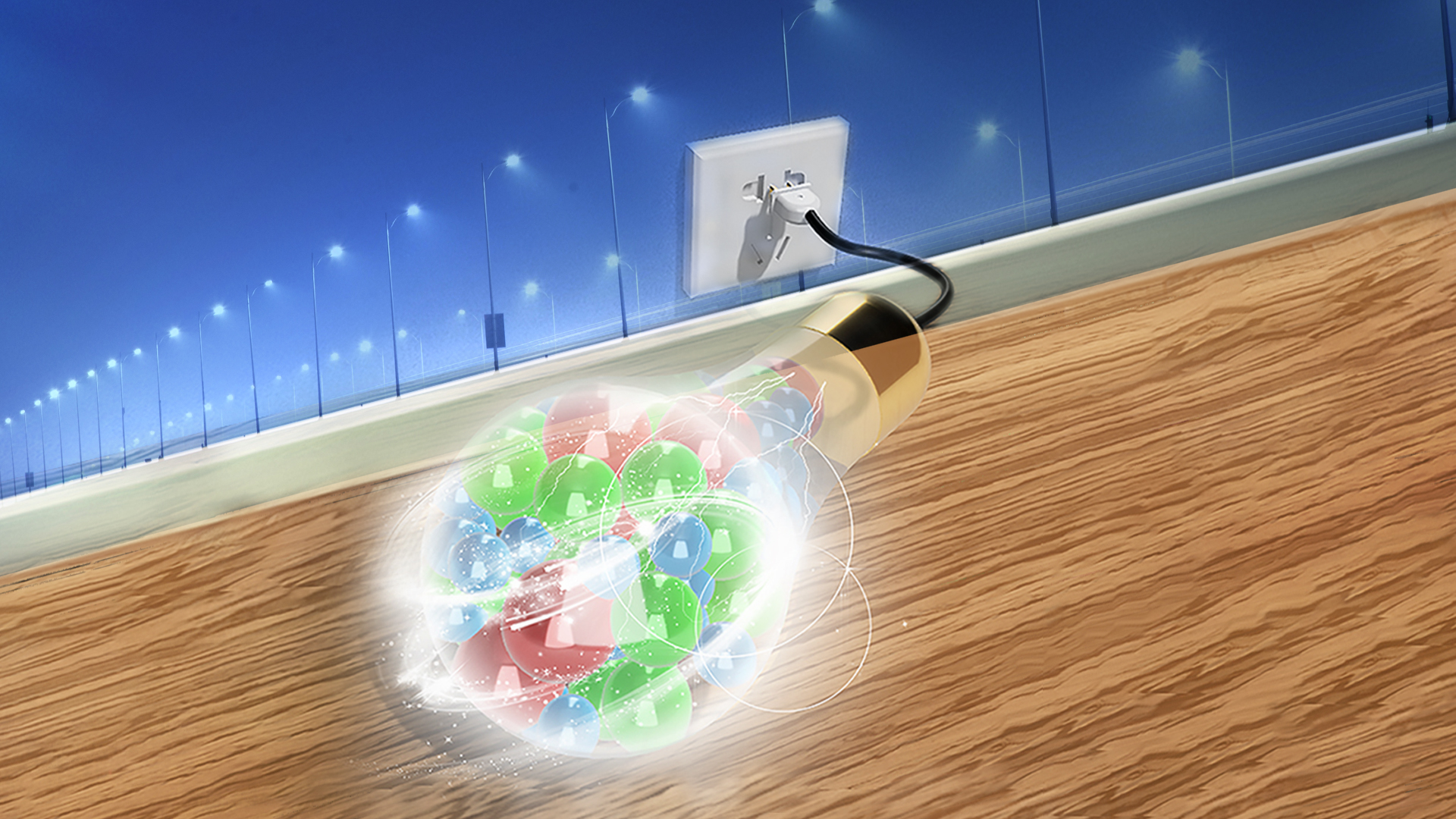
To address these issues, Associate Professor Shuming Chen’s research group from the Department of Electronic and Electrical Engineering at the Southern University of Science and Technology (SUSTech) has made a series of advancements in the field of QLEDs. They have developed a plug-and-play QLED (PnP-QLED) integrated with multiple tandem QLEDs in series. The proposed PnP-QLED can be directly driven by household alternating current (220 V/50 Hz) and offers the advantages of high efficiency, high brightness, and long lifetime. It is expected to promote the application of QLEDs in low-cost, compact, efficient, and stable solid-state lighting sources.
In addition, the researchers have achieved high efficiency and brightness of QLEDs through structural optimization, thus expanding the potential applications of QLEDs in next-generation displays and solid-state lighting. Moreover, to fulfill the cost-effective production demands for efficient, wide-color-gamut, stable displays, it is crucial to uncover the degradation mechanisms of QLEDs, guiding the realization of highly stable QLEDs. Currently, the degradation mechanisms of red and green QLEDs have been comprehensively revealed, leading to the achievement of stable devices. However, the degradation mechanism of blue QLEDs remains not fully understood, posing challenges in realizing stable blue QLEDs. Thus, they have further elucidated the degradation mechanism of blue QLEDs, providing crucial guidance for achieving stable blue QLEDs.
Their works have been published in multiple journals, including Nature Communications, Advanced Materials, and Laser & Photonics Reviews.
Revolutionary advances in household electricity-driven plug-and-play QLEDs
In their first work, the researchers proposed a tandem QLED consisting of a bottom QLED (B-QLED) and a top QLED (T-QLED) that are vertically stacked and connected by a transparent conductive indium zinc oxide (IZO) electrode in the middle (Figure 1). By employing different electrical connections, B-QLED and T-QLED can be connected in series or parallel. When connected in series, the tandem QLED operates in a conventional direct current (DC) mode (denoted as S-QLED). When connected in parallel (by extending the middle IZO electrode and short-circuiting the top electrode Al and the bottom electrode ITO), the tandem QLED can operate in an alternating current (AC) mode (denoted as AC-QLED).
Since B-QLED and T-QLED have opposite polarities in parallel connection, they alternately turn on and emit light under the AC power supply (Figure 1b). Compared to AC-driven light-emitting devices reported in the literature, this AC-QLED offers the following advantages:
1. Continuous emission: Under AC driving, B-QLED and T-QLED emit alternately, enabling the tandem QLED to emit steadily throughout the entire AC cycle.
2. High efficiency and long lifetime: B-QLED and T-QLED essentially operate in DC mode; thus, the AC-QLED exhibits similar high efficiency and brightness to DC-QLEDs. Additionally, under AC driving, B-QLED and T-QLED experience a half-cycle negative bias, effectively releasing accumulated charges within the device, thereby extending the lifetime of the AC-QLED.
3. Frequency compatibility: The tandem QLED is essentially composed of DC-QLEDs, and its frequency response depends on the response speed of the QLED, making it compatible with AC frequencies ranging from Hz to MHz.
Based on these advantages, the tandem QLED is the optimal candidate for achieving AC-driven, plug-and-play solid-state light sources.
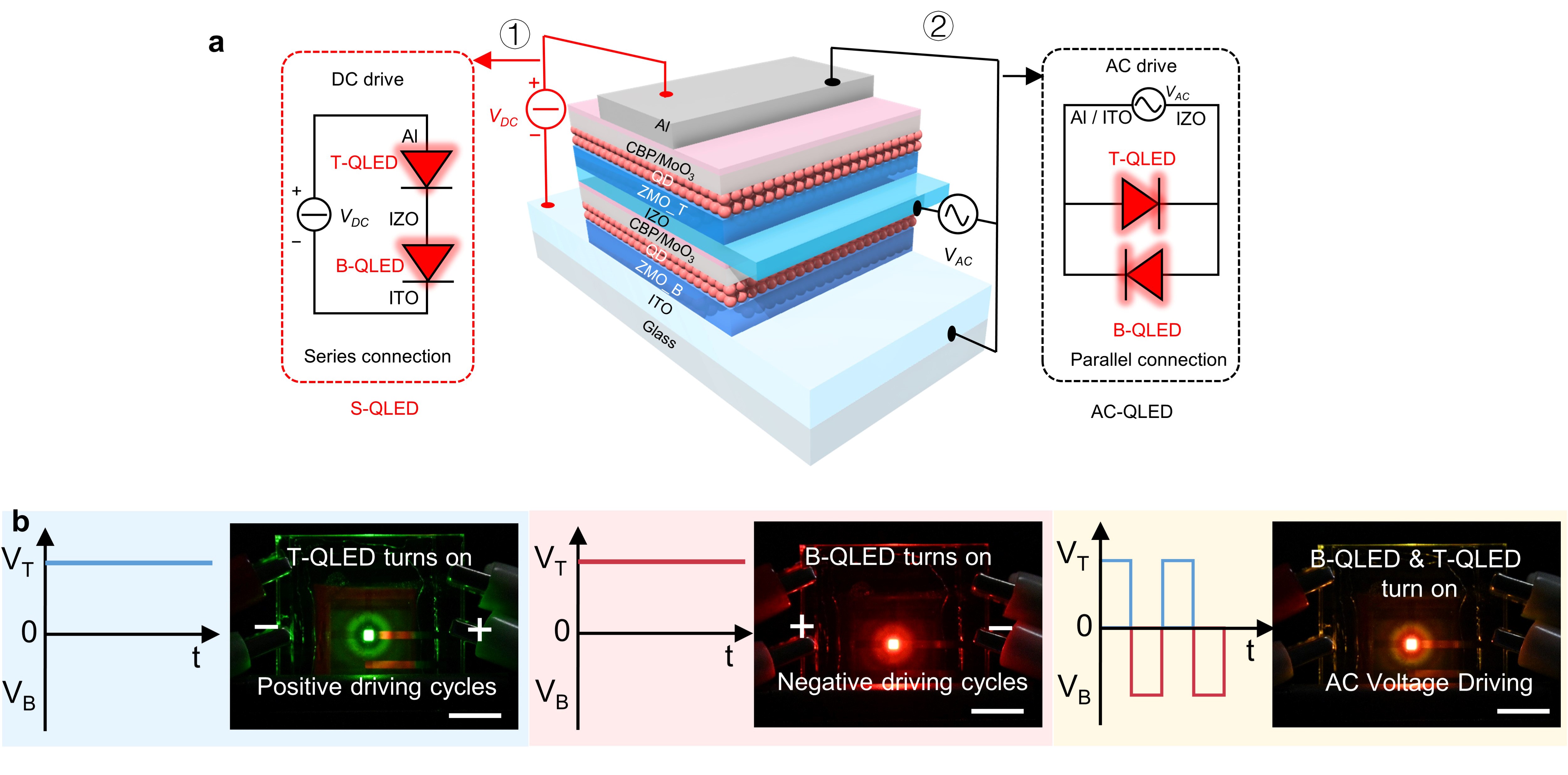
Figure 1. (a) Device structure. The tandem device consists of two vertically stacking QLEDs connected by an IZO intermediate electrode. The use of IZO enables the tandem device to operate in either direct current (DC) or alternating current (AC) mode. (b) The photos of a tandem device operated in alternating current mode at different driving conditions.
To enable the proposed tandem QLEDs to be directly driven by the high-voltage AC household electricity of 220 V, this study further connects multiple tandem QLEDs in series to increase the driving voltage of the device array. This allows the resulting lighting panel to be directly connected to 220 V/50 Hz household AC electricity. As illustrated in Figure 2a, a plug-and-play QLED (denoted as PnP-QLED) consists of two tandem QLEDs connected in series via an intermediate IZO electrode. This PnP-QLED emits light continuously and steadily throughout the entire AC driving process, enhancing the stability and reliability of the light source (Figure 2b). Furthermore, under AC driving, the operational lifetime of the PnP-QLED is 1.5 times that of DC-driven QLEDs. These results confirm that PnP-QLEDs can simultaneously achieve high efficiency and long lifetime.
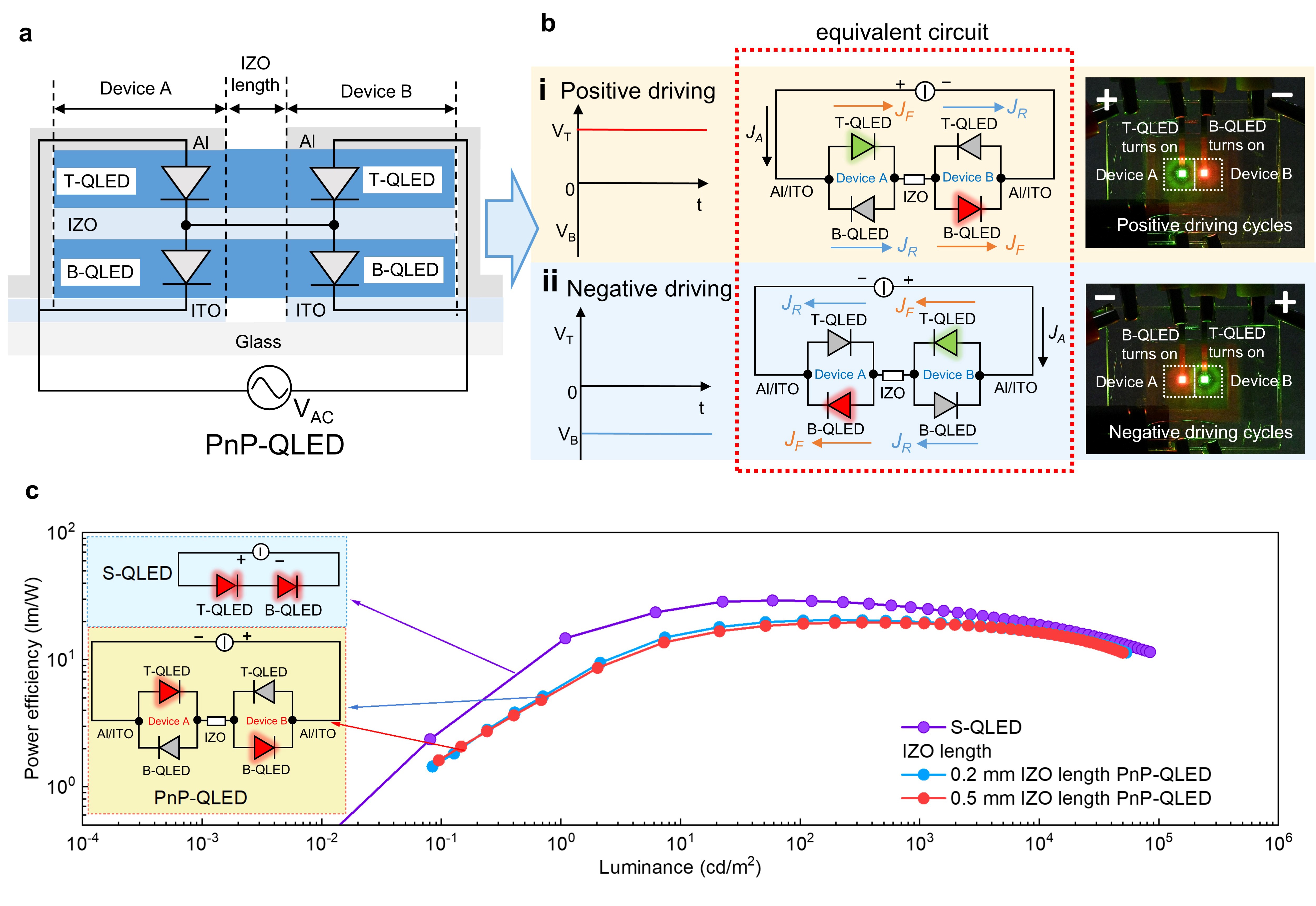
Figure 2. (a) Schematic device structure of a PnP-QLED. A basis PnP-QLED consists of two side-by-side AC-QLEDs connected in series. (b) Schematic circuit diagrams and photos of a PnP-QLED under the positive and negative driving cycles. (c) PE-L characteristics of PnP-QLEDs (the PnP-QLED with 0.2 mm/0.5 mm lengths of IZO wire) and S-QLED.
Furthermore, the researchers utilized the PnP-QLED as the fundamental building block and connected different numbers of PnP-QLEDs in series to achieve light sources, denoted as (PnP-QLED)n, which can operate directly at various AC voltages (Figure 3a). For example, by integrating 30 PnP-QLEDs, the resulting (PnP-QLED)30 can be directly connected to 220 V/50 Hz household AC electricity and continuously emit stable red, yellow, and white light (Figure 3d and Video 1). Moreover, to mitigate the flickering issue caused by AC driving, they further parallel-connected two (PnP-QLED)30 devices and adjusted the phase difference of the AC input for one (PnP-QLED)30 to achieve stable light output, effectively suppressing flicker (Figure 3f).
This work provides a novel technological approach for the realization of household AC-driven lighting sources. A patent application has been applied for the relevant technology.
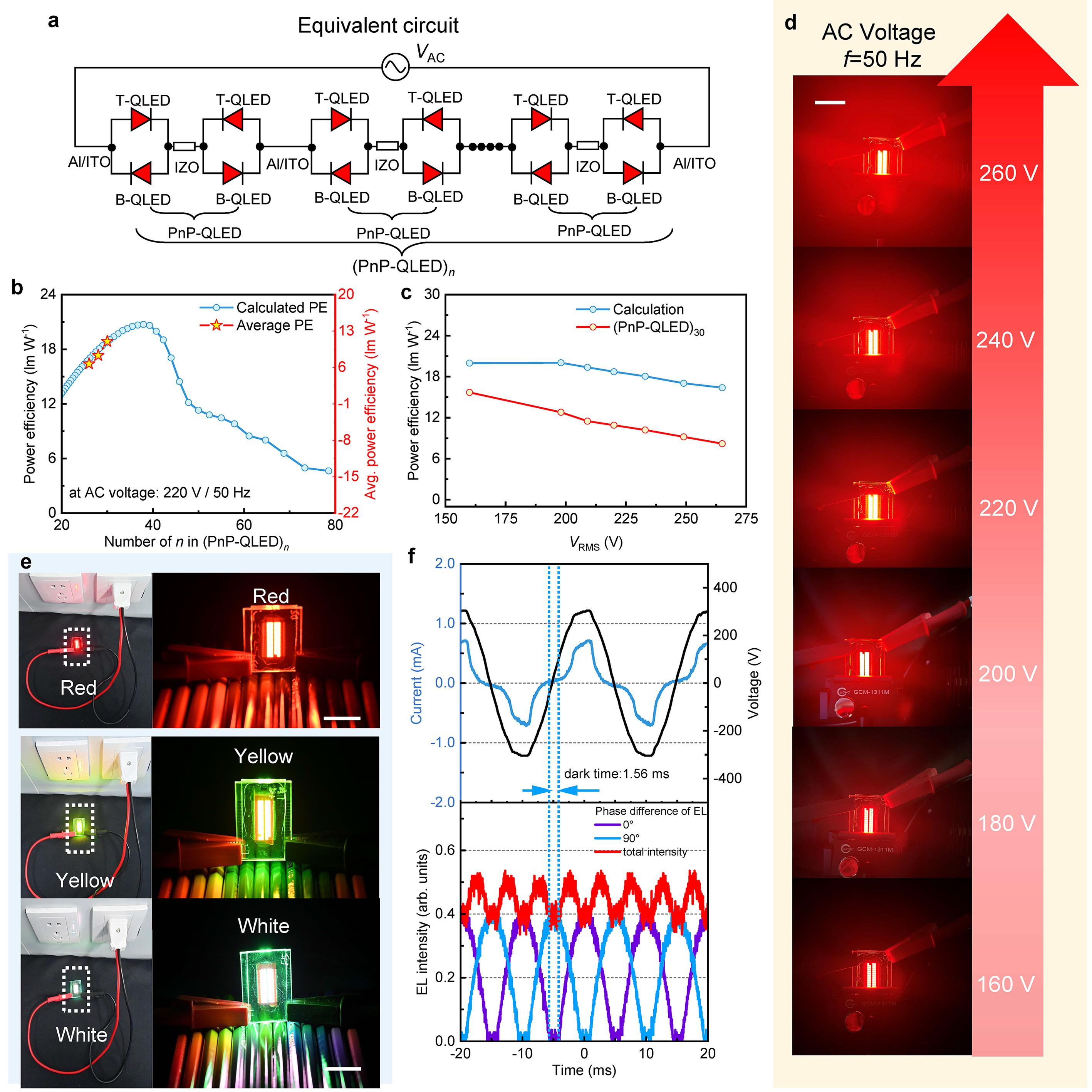
Figure 3. (a) Schematic circuit diagram of (PnP-QLED)n under AC driving. (b) The PE of (PnP-QLED)n as a function of n under the driving of 220 V/50 Hz AC electricity. (c) The PE of (PnP-QLED)30 as a function of the driving voltage. (d) The photos of (PnP-QLED)30 driven by different AC voltage levels. (e) The photos of red, yellow, and white (PnP-QLED)30 directly driven by 220 V/ 50 Hz household AC power supply. (f) The 220 V/50 Hz household AC voltage and the TrEL of (PnP-QLED)30 directly driven by 220 V/ 50 Hz household AC power supply with 0° and 90° phase, respectively.
Video 1. The developed red (n=30), yellow (n=28), and white (n=26) (PnP-QLED)n can be directly plugged into a household 220 V/50 Hz power supply without needing any accessories.
Their work, entitled “Household alternating current electricity plug-and-play quantum-dot light-emitting diodes”, has been published in Nature Communications.
Doctoral candidate Jiming Wang is the first author of the paper. Associate Professor Shuming Chen is the correspondent author, and SUSTech is the sole communication unit. This work was supported by the National Natural Science Foundation of China (NSFC) and the Shenzhen Science and Technology Program.
Innovative coplanar-electrode bipolar QLEDs directly driven by household AC electricity
In their subsequent work, the research group continued to innovate in the development of structures for household AC-driven QLEDs. They proposed a coplanar electrode QLED structure and developed new QLEDs compatible with household AC electricity.
In this study, by bridging with Al electrodes, the normal QLED structure and the inverted QLED structure are horizontally connected into series devices, resulting in the device (denoted as CEB-QLED) with coplanar driving electrodes (Figure 4). This novel CEB-QLED can operate under positive or negative bias voltages and exhibits excellent external quantum efficiency and brightness. Additionally, by using an Ag bridging layer, the brightness of CEB-QLED is further enhanced, achieving an outstanding external quantum efficiency of 22.2% and high brightness of 16,370 cd m-2, setting a new benchmark for bipolar devices’ performance.
Moreover, they also achieved light sources directly driven by 220 V/50 Hz household AC electricity by serially connecting multiple CEB-QLEDs without the need for additional driving circuits.
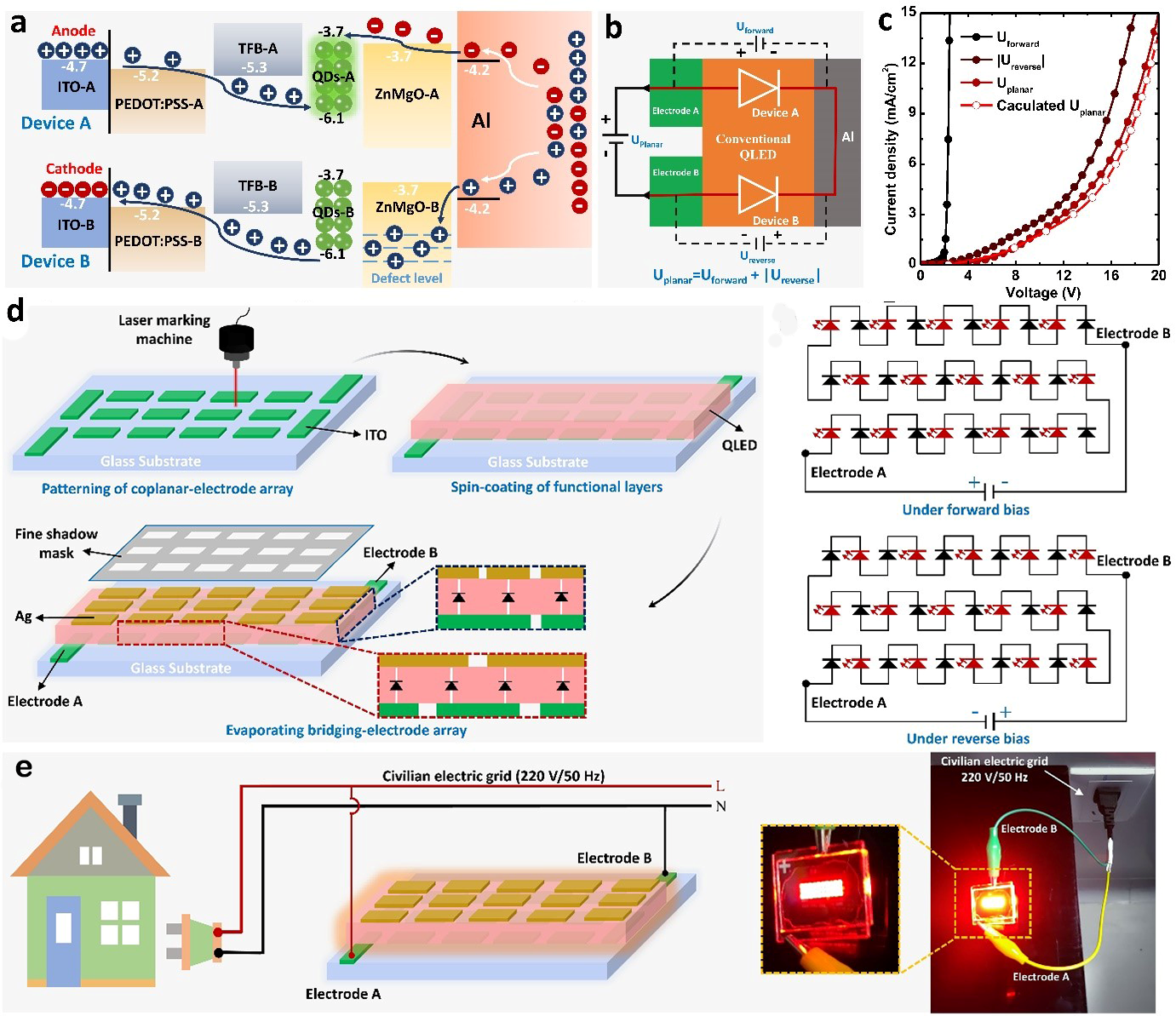
Figure 4. (a) Schematic diagram illustrating the principle of CEB-QLED and (b) equivalent circuit diagram. (c) J-V characterization of CEB-QLED. (d) Process flowchart and equivalent circuit diagram of (CEB-QLED)n. (e) Schematic diagram and photo of (CEB-QLED)n directly driven by 220 V/50 Hz household AC electricity.
This work, entitled “220 V/50 Hz compatible bipolar quantum-dot light-emitting diodes,” has been published in Advanced Materials.
Dr. Heng Zhang is the first author of this paper. Associate Professor Shuming Chen is the correspondent author, and SUSTech is the sole communication unit. This work was supported by the NSFC and the Shenzhen Science and Technology Program.
Record-breaking efficiency in top-emitting QLEDs
Regarding device structure, the research group proposed a novel top-emitting structure, which has significantly improved the device’s light emission efficiency. Traditional bottom-emitting QLEDs (denoted as BE-QLED) have relatively low light emission efficiency because photons emitted by the device need to pass through a transparent substrate (glass) to emit into the air. Due to the significant refractive index difference between the glass substrate and the air, some photons suffer total internal reflection at the glass/air interface, thus being waveguided by the substrate, leading to a reduction in device light emission efficiency.
Although many light extraction structures, such as microlenses, can be used to extract substrate mode, these structures may cause pixel blur or induce angle-dependent emission, making them unsuitable for high-resolution displays. Therefore, in this study, a dual IZO phase tuning layer was introduced into the structure of top-emitting QLEDs (denoted as TE-QLED), and its thickness was optimized to achieve a light outcoupling efficiency exceeding 45%.
By further equipping metal-assisted electrodes on the top IZO electrode, the current density and power efficiency of the QLED were significantly improved. Additionally, by spin-coating a SiO2 nanoparticle scattering layer on the device, the substrate mode was effectively extracted, ultimately achieving a record-breaking top-emitting QLED with an external quantum efficiency of up to 44.5%. The top-emitting device structure and optimization strategy provide new solutions for the realization of efficient QLEDs.
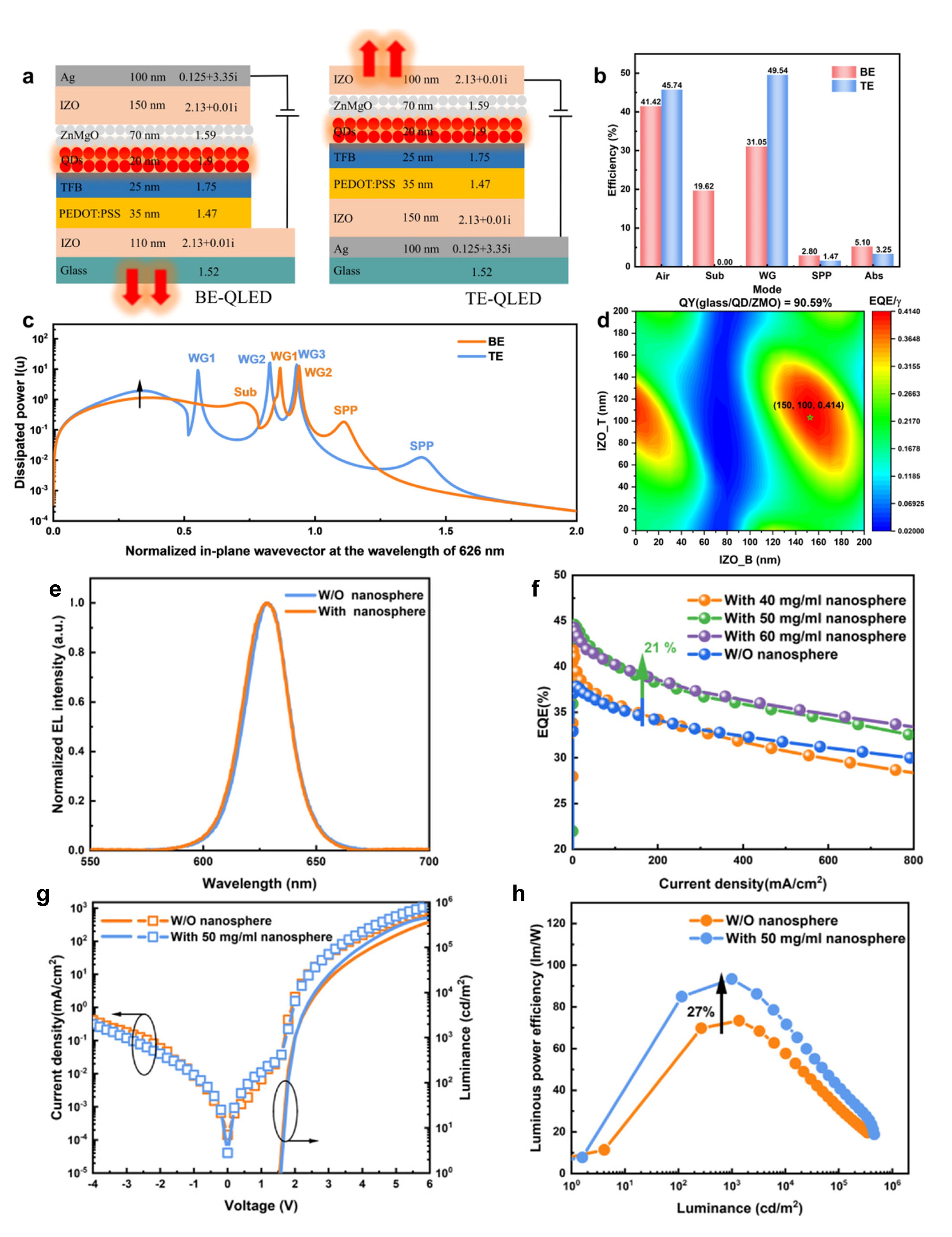
Figure 5. (a) The schematic device structure of BE-QLED and TE-QLED and the parameters for simulation at a wavelength of 626 nm. (b) Coupling efficiency of each mode of the devices based on BE and TE structures. (c) Power dissipation spectra of BE-QLED and TE-QLED at the wavelength of 626 nm in optimal structure. (d) The averaged EQE/γ as a function of the thicknesses of both bottom and top IZO phase tuning layers.
This related work, entitled “Highly efficient top-emitting quantum-dot light-emitting diodes with a record-breaking external quantum efficiency of over 44.5%”, has been published in Laser & Photonics Reviews.
Master’s student Haotao Li is the first author of this paper. Associate Professor Shuming Chen is the correspondent author, and SUSTech is the sole communication unit. This work was supported by the NSFC and the Shenzhen Science and Technology Program.
Understanding degradation mechanism of blue QLEDs
Regarding device mechanisms, the researchers revealed the detrimental effects of excess electrons on blue quantum-dot light-emitting diodes. By monitoring the changes in the photoluminescence of blue quantum dots and hole transport layers in situ during the operation of blue QLEDs, it was observed that the emission performance of blue quantum dots and hole transport layers gradually deteriorated. Further analysis of electron-only and hole-only devices revealed that the emission performance of blue quantum dots rapidly declined when electrons were injected into them.
Characterization of changes in the surface ligands of blue quantum dots revealed that injected electrons caused the detachment of oleic acid ligands from the surface of blue quantum dots, resulting in irreversible damage. Additionally, the accumulation of excess electrons in the device leaked into the hole transport layer, leading to electrochemical reactions and degradation of the hole transport layer, further exacerbating the aging of blue QLEDs.
This study provides insights into the strong dependence of the stability of blue QLEDs on the accumulation of electrons, surface ligands of blue quantum dots, and the hole transport layer in the device, aiding researchers in developing effective design strategies to improve the operational lifetime of blue QLEDs.
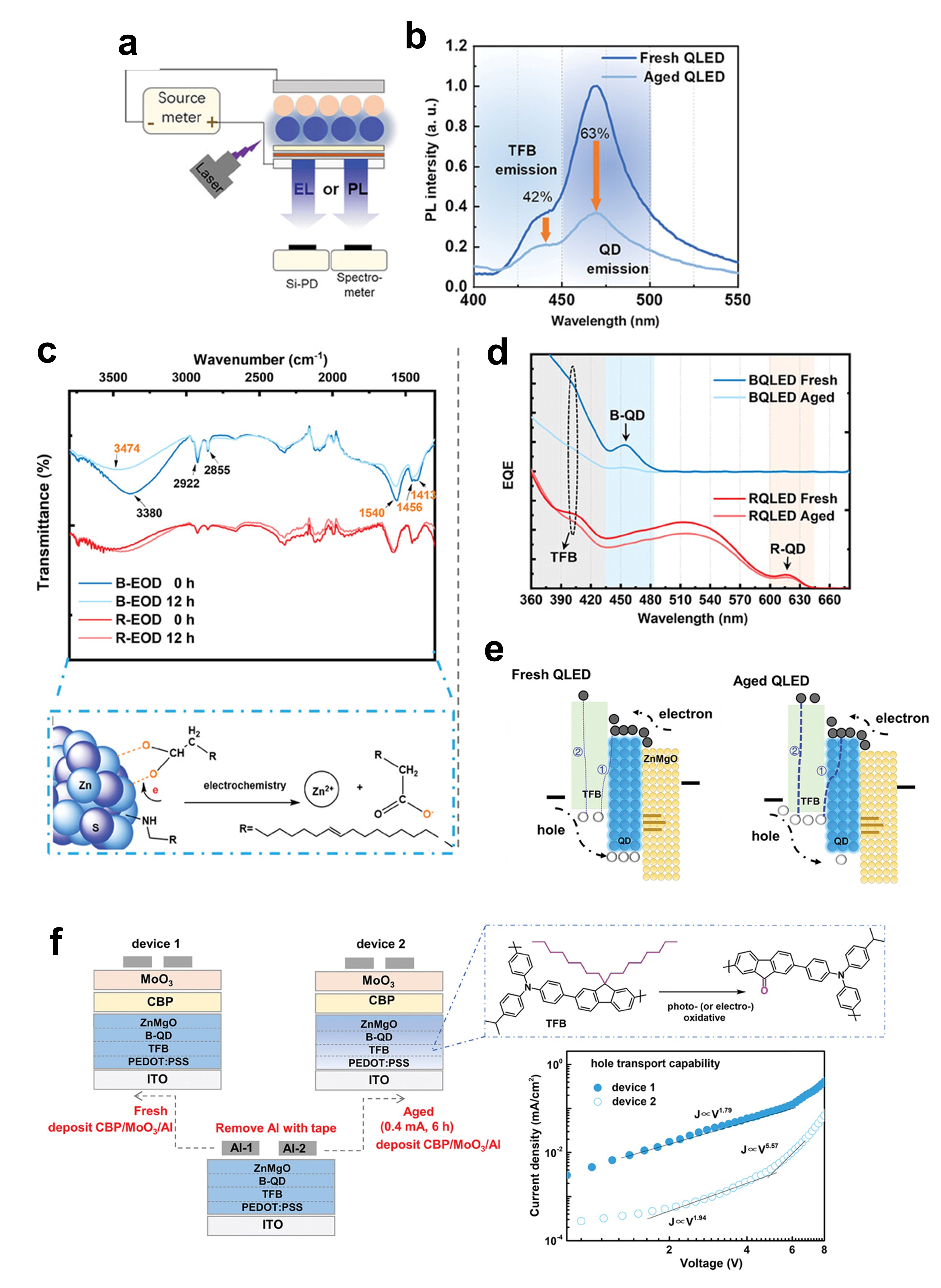
Figure 6. (a) The test principle of PL-EL. (b) The PL intensity of the fresh and aged Blue QLEDs. (c) The FTIR spectra of blue and red electron-only device before and after aging. (d) The sEQEPV spectra of blue and red QLEDs before and after aging. (e) Schematic diagram of charge injection before and after device aging. (f) Fabrication process of hole-only devices with aged blue QLED (device 2) and fresh blue QLED (device 1) and the J-V characteristics of the hole-only devices. The electro-oxidative reaction mechanism for the generation of keto defect sites in TFB.
This work, entitled “Electron-induced degradation in blue quantum-dot light-emitting diodes”, has been published in Advanced Materials.
Postdoctoral researcher Peili Gao is the first author of this paper. Associate Professor Shuming Chen is the correspondent author, and SUSTech is the sole communication unit. This work was supported by the NSFC and the Shenzhen Science and Technology Program.
Paper links (In order of appearance above):
Nature Communications: https://www.nature.com/articles/s41467-024-47891-4
Advanced Materials: https://onlinelibrary.wiley.com/doi/10.1002/adma.202312334
Laser & Photonics Reviews: https://onlinelibrary.wiley.com/doi/10.1002/lpor.202300371
Advanced Materials: https://onlinelibrary.wiley.com/doi/abs/10.1002/adma.202309123
To read all stories about SUSTech science, subscribe to the monthly SUSTech Newsletter.
Proofread ByAdrian Cremin, Yingying XIA
Photo ByDepartment of Electronic and Electrical Engineering